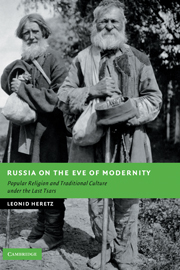Book contents
- Frontmatter
- Contents
- Acknowledgments
- Introduction
- 1 The traditional worldview
- 2 The Old Believers: modernization as apocalypse
- 3 The sectarians: dualism and secret history
- 4 Folk eschatology
- 5 The assassination of Alexander II (1881) and folk Tsarism
- 6 The year of famine and cholera (1891–1892): demonization of the nobility
- 7 The Japanese War: peasant Russia and the wider world
- 8 1905: revolution or reaction?
- 9 The Great War and the crisis of the traditional culture
- Epilogue
- Bibliography
- Index
- NEW STUDIES IN EUROPEAN HISTORY
6 - The year of famine and cholera (1891–1892): demonization of the nobility
Published online by Cambridge University Press: 23 December 2009
- Frontmatter
- Contents
- Acknowledgments
- Introduction
- 1 The traditional worldview
- 2 The Old Believers: modernization as apocalypse
- 3 The sectarians: dualism and secret history
- 4 Folk eschatology
- 5 The assassination of Alexander II (1881) and folk Tsarism
- 6 The year of famine and cholera (1891–1892): demonization of the nobility
- 7 The Japanese War: peasant Russia and the wider world
- 8 1905: revolution or reaction?
- 9 The Great War and the crisis of the traditional culture
- Epilogue
- Bibliography
- Index
- NEW STUDIES IN EUROPEAN HISTORY
Summary
If the assassination of Alexander II brought folk Tsarism into sharp focus, the misfortunes of the early 1890s, particularly the cholera epidemic that struck Russia, highlight a complementary issue, namely, the peasant identification of the nobility with the force of evil. The perception of a fundamental opposition between the lords and the people, and of a cultural chasm separating them, is of course a commonplace of the study of Russian history, and one of the most productive analytical categories in the field. An examination of popular thinking during the year of famine and cholera (1891–1892) will show that from the perspective of the people, the antagonism between the groups was even more drastic than educated Russians (and Western historians) have imagined: the opposition was absolute, in the context of the dualism inherent in the traditional worldview, and the conflict between the groups was understood in apocalyptic terms.
POINT OF ENTRY
In his memoir of the year of cholera, Stepan Anikin, a populist politician of peasant background, an astute observer of the people in late Imperial Russia, describes the following scene in the town of Astrakhan':
The people in the town were agitated. Crowds gathered in the bazaars, taverns, hiring points, and on the banks of the Volga. They spoke in a tone of grim accusation:
“Russia is finished. Killer disease has been let loose [Konets Rassei: moru napushcheno] … ”
God help him if they spotted a man dressed like a lord [“barinom”] in the crowd. Immediately, hundreds of inquisitorial eyes would glare, and knuckles would crack as fists tightened.[…]
- Type
- Chapter
- Information
- Russia on the Eve of ModernityPopular Religion and Traditional Culture under the Last Tsars, pp. 130 - 144Publisher: Cambridge University PressPrint publication year: 2008



